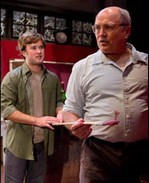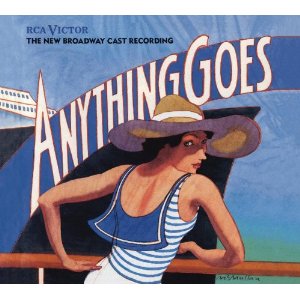SITE GUIDE
SEARCH
REVIEWS
REVIEW ARCHIVES
ADVERTISING AT CURTAINUP
FEATURES
NEWS
Etcetera and
Short Term Listings
LISTINGS
Broadway
Off-Broadway
NYC Restaurants
BOOKS and CDs
OTHER PLACES
Berkshires
London
California
New Jersey
DC
Philadelphia
Elsewhere
QUOTES
TKTS
PLAYWRIGHTS' ALBUMS
LETTERS TO EDITOR
FILM
LINKS
MISCELLANEOUS
Free Updates
Masthead
A CurtainUp Review
Red
|
"These pictures deserve compassion."— Rothko
|

Haley Joel Osment and Stephen Rowe
(Photo credit: Mark Garvin) |
The attractive and convincing artistís studio set, designed by James Noone for the Philadelphia Theatre Company production, includes large canvases stacked here and there. We get a good look at just a few of them. It would be rewarding if these stage Rothkos were featured more prominently, even though they canít speak to us in quite the way the artist describes his work, for PTC didnít shell out the necessary multi-millions for the real deals.
Stephen Roweís cranky Rothko comes across more like a small businessman than a painter, which is rather like Rothkoís actual persona. But although Rowe is an interesting actor, his performance paints a picture of an artist more irritable than intense. And intense is whatís needed on stage.
The show has its great moments. Itís a beautiful understatement when Ken, the painterís assistant (Haley Joel Osment) brings in a work of his own to show his boss. But as Rothko holds forth on various matters, Ken discreetly picks up his still-wrapped picture and takes it out of the studio unnoticed. His quiet act wordlessly underscores his realization that he will never make it to prodigy status, for his putative mentor has no interest in him or in his work.
We learn eventually that this story transpires over two years, but the passage of time doesnít show. Thatís one reason why Kenís apparently sudden change from a fairly inarticulate guy to an unusually perceptive person with a remarkable vocabulary is a stretch. But the transformation is needed for the playís central dialectic to function, even if it appears unlikely and exposes an error in construction.
Lectures and clever aphorisms donít work as the heart of this theater piece. While these elements are important ingredients, the play needs more silence, more grounding for the charactersí relationship, and in the case of this production, more blazing, transporting action. Talk takes primacy as potential moments of meaningful movement are reduced to stage business. A minor example: When Ken is supposed to staple a canvas to a frame, the director could have exploited the task for action. Instead, itís a lost opportunity as Osment fiddles with the corners of the canvas, apparently waiting for a cue. When he finally staples three or four times, it fails to read as a real task. With insufficient jobs to do on stage, what little activity there is --stirring the paint from time to time, or moving a canvas from one place to another-- looks a lot more like actors hitting marks than the labor involved in the making of art.
Director Anders Cato, who is interested in the viewer as collaborator, inexplicably has sacrificed a vital scene in order to indulge in theatrical effect. When Rothko and Ken prime a large canvas in red, Cato was inspired to turn the canvas around so that the actors are behind it, and we donít see them. What the audience sees is a dramatic narrowing of the light falling on the raw canvas as it is enclosed by paint and finally painted shut by the charactersí paint strokes. The lighting is great and itís a clever bit, but the canvas has become an obstacle, giving us passion once removed. What we donít see is the emotional act and the intense physical exertion that the play desperately needs here. Say there were to be two incidents of active painting. Then the arty one that shows only the effects on the canvas could be one of them. But if thereís only to be one scene like this, it has to be the depiction of Rothko, with his fierce gift, in the act of painting.
Playwright Logan sets up a provocative situation with a conflicted main character and a sort of sidekick character. Rothko harbors deep concerns for his earned place in art and he hates commercialism. Tortured by jealousies as the onslaught of a new generation of artists displaces his own, he rationalizes his acceptance of a commissioned Seagram mural project to decorate their centerpiece restaurant. He describes for Ken how he imagines the Four Seasons restaurant as a hushed, contemporary and contemplative temple of art, where his pictures will be safe.
When his assistant challenges his vision, Rothko actually visits the place, and his almost gleefully malicious description of the atmosphere and patrons he encountered is a priceless bacchanal of loathing. Isnít it a delectable thought that current and former denizens of that very establishment, the subjects of Rothkoís abhorrence, surely have been among the enthusiastic audience members for this show in London, New York, and here?
The wild success of the Donmar Warehouse productions in London and NYC, according to CurtainUp critics, owed much to intense acting, vibrant direction, and a foundation in solid stage activity. Based on the PTC performance, one could say that taken together, those superior elements were able to obscure the fact that this play with its grand talk and a hundred quotable quotes, harbors unresolved issues, like the important shift in the dynamic of the characters that takes place with insufficient causation, as the young man is a cipher.
The PTC production, while entertaining and intellectually intriguing, misses meaningful dramatic opportunities by favoring pronouncements over visceral engagement. Audiences will enjoy the show, but itís disappointing that it falls short of a soaring theatrical experience.
Personal note: Rothkoís description of his pictures pulsating is not just imaginative language used to talk about art. As ranks of Rothko aficionados can attest, itís real. His paintings truly pulsate and commune with each other. I attended a wonderfully designed exhibition at the Yale University Art Gallery some years back. Three bright Rothko canvases hung on facing walls in a contained space. As I looked at them, they vibrated together in an intense relationship. It felt as though I were the 4th painting, resonating with the others. A few years later at the Tate Modern when I saw the somber, saturated Seagram murals, dimly lighted and exhaling doom, it was a profound, but very different experience from the lift Iíd felt at Yale.
To read the more enthusiastic Curtainup reviews of the London and New York click here.
|
Red by John Logan
Directed by Anders Cato Cast: Stephen Rowe, Haley Joel Osment Scenic Design: James Noone Lighting Design: Tyler Micoleau Costume Design: Alejo Vietti Sound Design and composer: Josh Schmidt Oct 14 ĖNov 13, Opening 10/19/11 90 minutes Reviewed by Kathryn Osenlund based on 10/20/11 performance. At Suzanne Roberts Theatre, Avenue of the Arts |
|
REVIEW FEEDBACK Highlight one of the responses below and click "copy" or"CTRL+C"
Paste the highlighted text into the subject line (CTRL+ V): Feel free to add detailed comments in the body of the email. . .also the names and emails of any friends to whom you'd like us to forward a copy of this review. Visit Curtainup's Blog Annex For a feed to reviews and features as they are posted add http://curtainupnewlinks.blogspot.com to your reader Curtainup at Facebook . . . Curtainup at Twitter Subscribe to our FREE email updates: E-mail: esommer@curtainup.comesommer@curtainup.com put SUBSCRIBE CURTAINUP EMAIL UPDATE in the subject line and your full name and email address in the body of the message. If you can spare a minute, tell us how you came to CurtainUp and from what part of the country. |
 Anything Goes Cast Recording
Anything Goes Cast RecordingOur review of the show
 Book of Mormon -CD
Book of Mormon -CDOur review of the show

Slings & Arrows-the complete set
You don't have to be a Shakespeare aficionado to love all 21 episodes of this hilarious and moving Canadian TV series about a fictional Shakespeare Company

